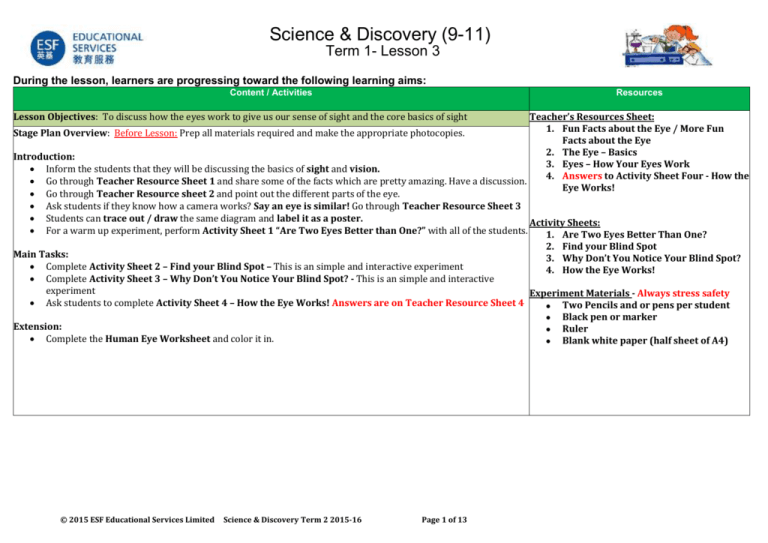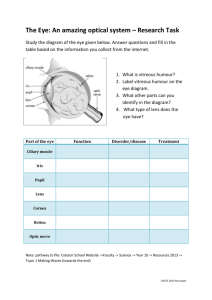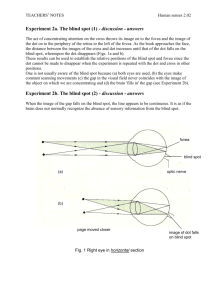Level 4/5 - Scheme of Work – Journeys Through Time
advertisement

Science & Discovery (9-11) Term 1- Lesson 3 455 During the lesson, learners are progressing toward the following learning aims: Content / Activities Resources Lesson Objectives: To discuss how the eyes work to give us our sense of sight and the core basics of sight Teacher’s Resources Sheet: 1. Fun Facts about the Eye / More Fun Stage Plan Overview: Before Lesson: Prep all materials required and make the appropriate photocopies. Facts about the Eye 2. The Eye – Basics Introduction: 3. Eyes – How Your Eyes Work Inform the students that they will be discussing the basics of sight and vision. 4. Answers to Activity Sheet Four - How the Go through Teacher Resource Sheet 1 and share some of the facts which are pretty amazing. Have a discussion. Eye Works! Go through Teacher Resource sheet 2 and point out the different parts of the eye. Ask students if they know how a camera works? Say an eye is similar! Go through Teacher Resource Sheet 3 Students can trace out / draw the same diagram and label it as a poster. Activity Sheets: For a warm up experiment, perform Activity Sheet 1 “Are Two Eyes Better than One?” with all of the students. 1. Are Two Eyes Better Than One? 2. Find your Blind Spot Main Tasks: 3. Why Don’t You Notice Your Blind Spot? Complete Activity Sheet 2 – Find your Blind Spot – This is an simple and interactive experiment 4. How the Eye Works! Complete Activity Sheet 3 – Why Don’t You Notice Your Blind Spot? - This is an simple and interactive experiment Experiment Materials - Always stress safety Ask students to complete Activity Sheet 4 – How the Eye Works! Answers are on Teacher Resource Sheet 4 Two Pencils and or pens per student Black pen or marker Extension: Ruler Complete the Human Eye Worksheet and color it in. Blank white paper (half sheet of A4) © 2015 ESF Educational Services Limited Science & Discovery Term 2 2015-16 Page 1 of 13 Teacher Resource Worksheet 1: The average blink lasts for about 1/10th of a second. While it takes some time for most parts of your body to warm up to their full potential, your eyes are on their “A game” 24/7. Eyes heal quickly. With proper care, it only takes about 48 hours for the eye to repair a corneal scratch. Seeing is such a big part of everyday life that it requires about half of the brain to get involve New-borns don’t produce tears. They make crying sounds, but the tears don’t start flowing until they are about 4-13 weeks old. Doctors have yet to find a way to transplant an eyeball. The optic nerve that connects the eye to the brain is too sensitive to reconstruct successfully. The cells in your eye come in different shapes. Rod-shaped cells allow you to see shapes, and cone-shaped cells allow you to see color. You blink about 12 times every minute. Your eyes are about 1 inch across and weigh about 0.25 ounce. Some people are born with two differently colored eyes. This condition is heterochromia. Each of your eyes has a small blind spot in the back of the retina where the optic nerve attaches. You don’t notice the hole in your vision because your eyes work together to fill in each other’s blind spot. Out of all the muscles in your body, the muscles that control your eyes are the most active. 80% of vision problems worldwide are avoidable or even curable. © 2015 ESF Educational Services Limited Science & Discovery Term 2 2015-2016 Page 2 of 13 Teacher Resource Worksheet 1 Continued: Clams have a row of eyes around their shells. Fly eyes are made of hundreds of separate little eyes. An eagle can see a rabbit about 1 mile away. A camel's eyelashes can be as long as 4 inches to protect its eyes from all of that sand! An owl can see a mouse moving over 150 feet away with light no brighter than a candle! A cat's eyes glow in the dark because of silvery "mirrors" that reflect light and make it easier for them to see in the dark Predatory animals generally have eyes on the front of their heads so they can track prey. Animals of prey have eyes at the sides of their heads so they can see predators sneaking up on them © 2015 ESF Educational Services Limited Science & Discovery Term 1 2015-2016 Page 3 of 13 Teacher Resource Worksheet 2: Iris - front part of the choroid, usually blue, green or brown in colour Pupil - black circle in middle of the iris through which light enters the eye Cornea - bulged, clear part of the sclera in front of the lens Sclera - tough outermost layer of the eye which is mostly white (the cornea is the clear part of the sclera) Choroid - second layer of the eye, contains blood vessels, iris and muscles attached to the lens which cause if to change shape for focussing Retina - innermost layer of the eye – contains cells called rods and cones which are sensitive to light Cones - light sensitive cells responsible for colour vision and seeing detail Rods - light sensitive cells responsible for vision in low light Macula - small sensitive region in the centre of the back of the retina – this is where you see an object when you are looking directly at it – the very centre of the macula, called the fovea, is where you see the finest detail Optic disk - where the optic nerve and blood supply enter the eye – there are no rods or cones in this part of the retina so it is a ‘blind spot’ © 2015 ESF Educational Services Limited Science & Discovery Term 2 2015-2016 Page 4 of 13 Teacher Resource Worksheet 3: Your eyes are like a wonderful kind of camera. They take pictures of the world around you and send the pictures to your brain. Your brain works out what your eyes are seeing. This happens from the moment that you open your eyes in the morning to when you close your eyes at night. How a camera works The light rays from an object pass through the lens of the camera and get recorded on a film or a computer chip. Do you notice something about this drawing? Yes, the picture that is recorded by the camera is upside down (of course, when you look at the picture as a printed photo or on a computer screen, it is not upside down.) How your eyes work Your eye works in a similar way to a camera - light passes through the lens of your eye and is 'recorded' on the back of your eye (the retina). Do you notice something about this drawing? Yes, the picture that your eye takes is upside down too! Why don't you see things upside down? Well, your eye sends the picture to your brain, and your brain turns the picture the right way up and tells you what you are looking at. So you see things the right way up. © 2015 ESF Educational Services Limited Science & Discovery Term 1 2015-2016 Page 5 of 13 Teacher Resource Worksheet 4: ANSWERS: 1. 2. 3. 4. 5. 6. 7. Cornea. Outermost transparent layer of eye. Begins focusing process. Pupil. Opening to the inner eye. Iris. Controls size of pupil. Lens. Focuses image of object (on retina). Retina. Contains cells that detect light. Ciliary muscle. Controls shape of the eye. Optic Nerve. Transmits information to the brain. © 2015 ESF Educational Services Limited Science & Discovery Term 2 2015-2016 Page 6 of 13 Activity Sheet 1: Experiment Objective: How two eyes give you more depth perception, which is the ability to judge how near or far objects are. What is Needed? Two pencils What to do? 1. Hold a pencil lengthwise (on its side) in each hand. 2. Now, with one eye closed, try to touch the erasers together. Did you miss? 3. Now, try it with both eyes open. Voila! Two eyes give you better depth perception. © 2015 ESF Educational Services Limited Science & Discovery Term 1 2015-2016 Page 7 of 13 Activity Sheet 2: Most people aren’t aware that each of their eyes has a blind spot. This is because you are not normally aware of it. In this activity, you will use a very simple method to find your blind spot. Once you have seen that there really is a blind spot, you will learn why it is there. Materials required: Black pen or marker, Ruler, Blank white paper (half sheet of A4) What to do: 1. Fold the paper in half along the short edge and draw a black cross and a solid black circle as illustrated. The circle and cross should be about 1cm wide and roughly 7cm apart. 2. Hold the ruler in front of your nose a little. Hold the paper at the end of the ruler so that the cross is on the right hand side. 3. Keep your right eye closed or covered and look at the paper with your left eye. 4. Look directly at the cross with your left eye and slowly move the paper towards your face. Take notice of what happens to the circle as you do this, but keep looking directly at the cross. At a certain distance, the dot will disappear from view. As you keep moving the paper towards you, it will reappear. 5. Once you have found your left eye’s blind spot, repeat the activity for your right eye. Cover your left eye and hold the paper so the cross is now on the left hand side. © 2015 ESF Educational Services Limited Science & Discovery Term 2 2015-2016 Page 8 of 13 Activity Sheet 2 Continued: All the nerves inside your eye exit through one point as a little bundle called the optic nerve. The eye’s blood supply also enters and exits through this point which is called the optic disk. The optic disk is a part a special layer called the retina at the back of your eye. The retina contains millions of cells which are sensitive to light. The optic disk is a blind spot because it is packed with nerves, arteries and veins, but no light sensitive cells. When the circle is focused onto your optic disk, it disappears. What’s going on? When it is focused onto any other part of your retina, you can see it again. Just beside your optic disk is another very small but important area called the macula. The macula is directly behind the lens and is where objects are focused when you look directly at them. It is packed with more light sensitive cells than any other part of your retina. Here, you can see fine details. Keeping the cross focused on your macula helps you find your blind spot, right next to your macula. © 2015 ESF Educational Services Limited Science & Discovery Term 1 2015-2016 Page 9 of 13 Activity Sheet 3 Now that you know you have a blind spot, you might be wondering why you never noticed it before. It’s because your brain fills in the blanks. To prove this, do the following activity. Materials required: Black pen or marker, Ruler and paper What to do 1. Draw a line straight through the cross and the circle as illustrated. 2. Repeat activity 1. You will notice that the line appears to be unbroken even when the circle is on your blind spot! What’s going on? Your blind spot would be very annoying if it was noticeable. Somehow, your brain looks at what the eye is seeing and fills in the blank. Some people think our brain fills in the blanks by using what the other eye sees. This activity proved that your brain doesn’t need the other eye to fill in the blanks. © 2015 ESF Educational Services Limited Science & Discovery Term 2 2015-2016 Page 10 of 13 Activity Sheet 3 continued: After images Materials required: Blank paper or a white wall What to Do: 1. Hold this page about 30cm from your eyes and stare at the dot in the centre of the black circle for at least 25 seconds. 2. Now stare at a sheet of White paper or a wall, and blink a few times. Do you notice something funny going on? What’s going on? The bright ring you saw was the result of your eyes amazing ability to adjust to different light levels. There are millions of light sensitive cells on your retinas. Each of them adjusts to brightness or darkness all by itself. When bright light hits one of these cells, a chemical is released inside to make it less sensitive to light. But this chemical takes a while to get released and start doing its job. That’s why it takes a while to see clearly when you first enter bright sunlight. It also takes a while to see clearly when you enter a dark room because it takes a while for the chemical to get used up again. The image you stared at is dark (black) in some places and bright white in others. While you stared at the image, the cells that saw the white paper became less sensitive to light. The cells that saw the dark ring reacted as though they were in a dark room and became more sensitive to light. As a result, they were sending stronger signals to your brain than those that had been staring at the white paper. © 2015 ESF Educational Services Limited Science & Discovery Term 1 2015-2016 Page 11 of 13 Activity Sheet 4 Below is a drawing of the eye with some of the more important parts numbered. Match the names of the parts of the eye and their functions in the proper boxes. The clue list is there to help you. Part Names Lens Retina Ciliary Muscle Optic Nerve Pupil Cornea Iris Functions Contains cells that detect light Opening to the inner eye Controls the size of the pupil Focuses image of object Controls shape of lens Transmits information to brain Outermost transparent layer of eye, begins focusing process © 2015 ESF Educational Services Limited Science & Discovery Term 2 2015-2016 Page 12 of 13 Extension: © 2015 ESF Educational Services Limited Science & Discovery Term 1 2015-2016 Page 13 of 13







